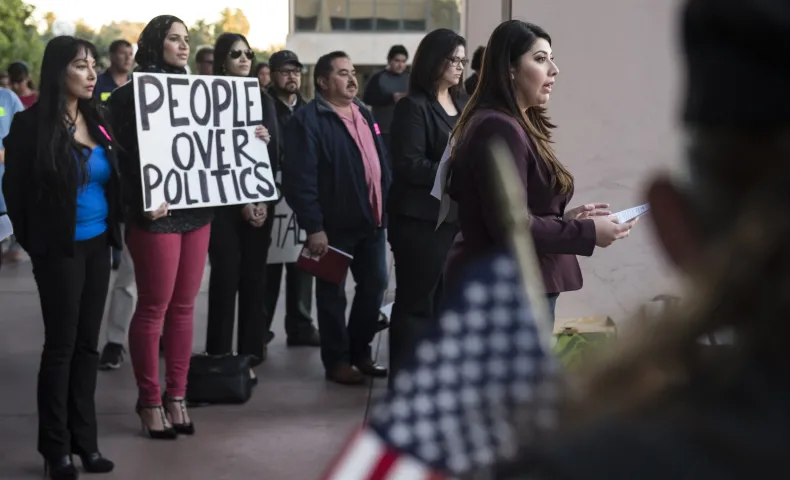 Photo by Orange County Register
Photo by Orange County Register
A Pro-Immigrant Winning Strategy
This story was originally published by the National Committee for Responsive Philanthropy.
In the year after the 2016 election, the immigration movement in California offered a hopeful example on how to resist the increasingly anti-immigrant policies and rhetoric emanating from Washington, D.C.
Movement leaders in the state, such as the California Immigrant Policy Center, National Day Laborer Organizing Network and Asian Americans Advancing Justice—Asian Law Caucus, led the way in advancing laws to prevent California from participating in any potential Muslim registry, restrict police cooperation with federal immigration authorities and block expansion of immigrant detention centers, among other priorities.
Californians know that immigration boosts the economy and strengthens families and communities; when government adopts pro-immigrant laws and policies, it helps everybody, immigrants and non-immigrants alike.
As a result, California is now one of the most immigrant-affirming states in the nation. This has happened with the help of a years-long partnership between philanthropy and immigrant rights leaders to build a powerful statewide movement for change.
“Following the 2016 election, our advocates and communities were unified, proactive and ready for anything,” said Cathy Cha, president of the Evelyn and Walter Haas, Jr. Fund.
A long-term view with grantee partners leading the way
Based in San Francisco, Haas, Jr. has been a leading supporter of California’s immigration movement alongside other funders like the Rosenberg Foundation, James Irvine Foundation, California Endowment and local community foundations in San Francisco, Napa and Los Angeles.
As the Haas, Jr. Fund began investing in the movement in the early 2000s, Cha and her colleagues focused on supporting groups around the state to strengthen their capacity and skills in areas such as organizing and voting, policy analysis, leadership development and strategic communications.
Haas, Jr. also made investments to help groups come together, giving them the space to identify shared priorities, and then supporting those priorities.
Filling gaps and laying a foundation for movement-building
The first priority the groups picked was strengthening the ability of the movement to communicate about the contributions of immigrants to California.
Advocates around the state were struggling to get their voices heard in a media and policy environment where anti-immigrant messages ruled the day. So Haas, Jr. supported the movement to develop its own messaging toolkit and train community members as spokespeople.
“Focusing on communications was a safe first step that galvanized groups to work together on a common goal,” said Cha. “In the process, they were able to build trust and change the narrative of immigrants from problems to contributors and assets, which laid the groundwork for many more eventual policy wins.”
Enforcement reform is a second priority embraced by advocates. Groups across the state initially worked together on limiting the ability of local police to use DUI checkpoints to identify undocumented immigrants and impound their cars.
It wasn’t a headline-grabbing policy change—and it wasn’t something Haas, Jr. would have identified as a priority—but it was a crucial building block toward achieving more ambitious goals because of broad-based interest in the issue.
Sharp increase in pro-immigrant laws and support for legal services
As the movement found its collective voice and grew stronger, the wins kept coming; in the last 7 years, California has passed scores of pro-immigrant laws and dedicated budget allocations to support immigrants.
An important early victory was the California Dream Act in 2011, which provides Dreamers attending state colleges and universities with access to financial aid and private scholarships.
California subsequently enacted laws that have allowed more than 1 million undocumented immigrants to get driver’s licenses, a life necessity in a sprawling state and a step that’s been shown to increase the number of insured drivers and improve road safety for everyone.
For workers, the state extended overtime pay to domestic workers and enabled qualified undocumented immigrants to become lawyers, real estate agents and other licensed professionals.
California also was the first state to extend government-funded health care, known as Medi-Cal, to low-income undocumented children; the state is currently considering expanding coverage to undocumented young adults up to 28 years of age.
Since the 2015-2016 budget year, California has allocated more than $150 million for free legal services to immigrants for immigration-related matters. In 2017, the state added more funds for these services in response to the repeal of Deferred Action for Childhood Arrivals (DACA), the executive order that provided temporary work authorization for undocumented immigrants brought to this country as children.
With immigrants comprising 1/3 of the California workforce, these laws are a common-sense approach to ensuring that immigrant workers can continue to support their families and contribute to the state economy.
Let local groups lead with their issues, not yours
California’s leadership in advancing pro-immigrant policies highlights 2 important takeaways for philanthropy.
First, California’s success was due in part to funder flexibility and following the immigrant movement’s lead. High-priority actions that originate with community members rather than with foundation staff galvanize more community members, unite advocates and have staying power.
“We found that the best way to help the movement grow stronger was to stay flexible and give people the freedom to work on issues that resonated with the grassroots,” said John Govea, Haas, Jr.’s program director for immigrant rights.
Second, California’s transformation to one of the country’s most pro-immigrant states affirms the value of patient, multi-year philanthropic support for movement building. As Cha put it, “Bold leaps forward don’t happen in grant cycles.”
“When you’re funding single-issue campaigns, you might get a win, but then you have to start over and rebuild for the next campaign,” she said. “The difference when you invest in movements is that you’re supporting groups to build sustainable muscles, work together and adapt to whatever challenge or opportunity comes next. You can’t get a better return on your philanthropic investments than that.”